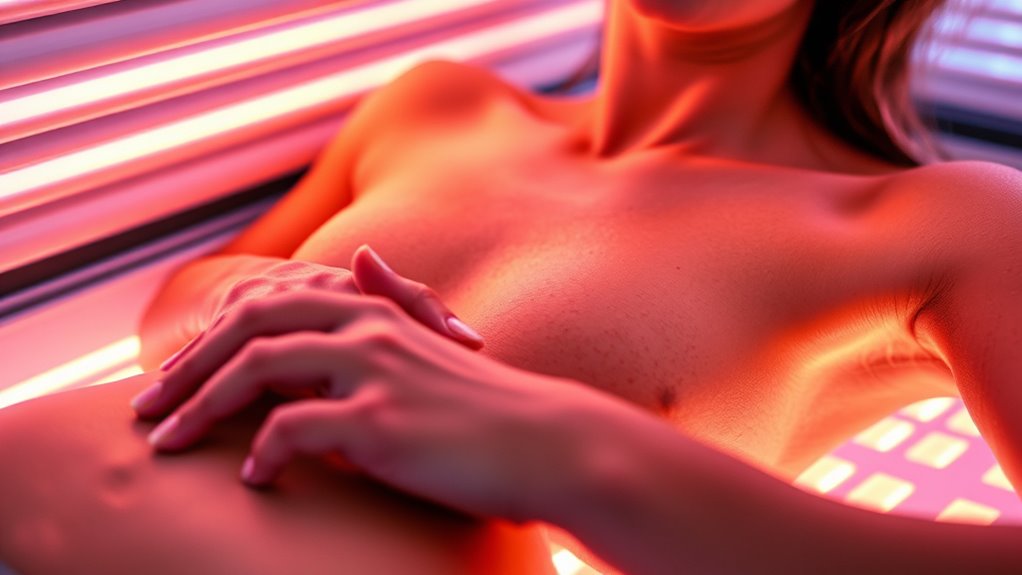Using tanning beds more than 2-3 times weekly, with at least 48 hours between sessions, can markedly raise your risk of skin damage, premature aging, and skin cancers. Starting with shorter sessions and gradually increasing helps prevent burns and overexposure. Your skin type and health status also influence safe limits. If you want to find out how to enjoy a glow while protecting your skin, explore the full guidance ahead.
Key Takeaways
- Limit sessions to 2-3 times per week, spaced 48 hours apart, to reduce skin damage risk.
- Start with 3-10 minute sessions, gradually increasing only if skin shows no irritation.
- Avoid daily tanning; frequent sessions increase cumulative UV exposure and skin cancer risk.
- Follow recommended guidelines based on skin type and health considerations to prevent overexposure.
- Monitor skin for signs of damage or overuse, such as burns, age spots, or unusual moles, and adjust accordingly.
Understanding the Risks of Frequent Tanning Bed Use

Understanding the risks of frequent tanning bed use is essential because these sessions can profoundly harm your health. Every time you step into a tanning bed, you’re exposing your skin and eyes to intense UV radiation that increases your chances of developing skin cancers like basal cell carcinoma, squamous cell carcinoma, and melanoma. The risk of squamous cell carcinoma rises by 58%, and basal cell carcinoma by 24%, with indoor tanning. Starting before age 35 markedly boosts melanoma risk by 75%. Both UVA and UVB rays contribute to cancer development, and the damage accumulates over time. The World Health Organization classifies tanning beds as carcinogenic, similar to cigarettes. The more you use them, the greater the DNA mutations and long-term health consequences. Your skin and eyes face irreversible damage with frequent use. Additionally, understanding the role of contrast ratio in images can help you recognize the importance of consistent and safe UV exposure.
Recommended Tanning Sessions for Beginners and Regular Users

If you’re new to tanning beds or want to maintain a safe routine, it’s essential to follow recommended session guidelines. Begin with 2-3 sessions per week, spaced 48 hours apart, giving your skin time to recover. Start with 3-10 minutes, adjusting based on your skin type—about 5 minutes for sensitive skin on low-level beds. Gradually increase session time by 2-minute steps if no irritation occurs, but avoid overexposure. Always monitor your skin for burns or redness; if you notice any, cut back on duration or frequency. Use Level 1 or 2 beds initially, as higher UV intensities increase burn risk for beginners. Following these guidelines helps build a safe, controlled tanning routine while minimizing skin damage. Incorporating safety measures such as protective eye wear and limiting exposure can further reduce risks. Additionally, understanding UV radiation and its effects can help you make informed decisions about your tanning habits. Being aware of toxic effects associated with excessive UV exposure underscores the importance of moderation in tanning routines. Moreover, considering the right session length tailored to your skin type can prevent overexposure and skin damage.
How Tanning Frequency Impacts Skin Health

Frequent use of tanning beds markedly increases your risk of developing skin cancer, and the danger escalates with each session. Every additional session raises your chances of basal cell carcinoma (BCC), squamous cell carcinoma (SCC), and melanoma. Starting tanning early, especially before age 20, boosts melanoma risk by nearly 47%, and beginning before 30 raises it about 75%. The more often you tan, the greater your cumulative UV exposure, which damages your skin over time. This dose-response relationship means that regular, repeated sessions amplify the risk considerably. Use during high school or college years has a stronger impact on certain cancers like BCC. Overall, frequent tanning not only accelerates skin aging but also substantially elevates your likelihood of serious skin cancers later in life. Ultraviolet radiation exposure is a major factor contributing to skin damage and cancer risk. Additionally, vocal performance plays a crucial role in educational and health campaigns aimed at raising awareness about these risks. Moreover, understanding cybersecurity vulnerabilities, such as those exploited during system outages, highlights the importance of robust safety measures in health communications.
Identifying Signs of Excessive Tanning Bed Sessions

Excessive tanning bed sessions often leave visible signs on your skin, signaling overexposure to UV rays. You might notice severe redness or sunburn-like symptoms immediately after sessions, or blistering and peeling skin indicating acute damage. Over time, leathery or thickened skin can develop early, along with age spots, wrinkles, or loss of firmness appearing sooner than normal aging. Persistent soreness, hot skin sensations, or increased sensitivity after tanning sessions also suggest overuse. Behavioral signs include cravings to tan, neglecting social or work activities, guilt, anxiety, or feeling out of control with your tanning habits. Watch for skin changes like unusual moles, non-healing sores, or rough patches. These physical and behavioral cues help you recognize when your tanning sessions are excessive and potentially harmful. Additionally, repeated exposure can accelerate skin aging processes, making early signs of aging more prominent than natural development. Regular exposure to UV rays can also cause DNA damage that compromises your skin’s health and resilience. Understanding UV damage and its effects can help you make informed choices to protect your skin’s health. Regularly using broad-spectrum sunscreen can help minimize damage and protect your skin’s health. To better understand the risks, it’s important to recognize skin aging signs and take steps to limit overexposure.
The Role of Skin Type and Personal Health in Session Limits

Your skin type and overall health play crucial roles in determining safe tanning bed session limits. If you have Type 1 skin, your sensitivity means you should stick to five to eight minutes per session and avoid overexposure. For Type 2 skin, starting with two to four minutes and gradually increasing to ten or twelve minutes after four weeks is safer. Those with Type 3 skin can begin with four to eight minutes, adding one-minute increments. Naturally darker Type 4, and Types 5 and 6 skin, usually tolerate longer sessions without burning. Your health conditions, medications, and age also influence how often you should tan. If you have skin issues or are on medication that increases UV sensitivity, consult a healthcare professional before tanning. Always prioritize your skin’s response and health for safe session limits. Incorporating personalized tanning routines and listening to your skin’s signals can help you find a sustainable balance. Additionally, understanding skin types can help you tailor your tanning schedule more effectively. Recognizing the importance of moderation and UV exposure risks can prevent overexposure and skin damage over time.
Alternatives to Tanning Beds for a Safe Glow

For those seeking a safe and effective way to achieve a bronzed look, there are several sunless alternatives to tanning beds. Spray tanning booths offer a UV-free option by applying a fine mist of DHA, creating an even, natural-looking tan without UV exposure. Professional booths provide consistent results with less mess, making them ideal for special occasions. Self-tanning products like lotions, gels, and mousses also use DHA to develop color safely at home, often with added skin benefits like hydration and reduced breakouts. Natural options such as bronzers, tinted moisturizers, and gradual tanning lotions allow you to build a subtle glow without chemicals or UV rays. Many sunless products now include antioxidants and moisturizers, promoting healthier skin while giving you a radiant, sun-kissed appearance.
Frequently Asked Questions
Can Tanning Bed Frequency Affect Different Skin Types Differently?
You might wonder if how often you tan impacts your skin differently. The answer is yes. Fair skin is more sensitive and burns easily, so you should tan less often to prevent damage. Medium and darker skin types can usually handle more frequent sessions, but moderation still matters. Always listen to your skin’s response and adjust your tanning schedule accordingly to avoid overexposure and harm.
What Are the Long-Term Health Effects of Occasional Tanning Bed Use?
Long-term health risks linger even with occasional tanning bed use. You risk raising your chances of skin cancers like melanoma, basal, and squamous cell carcinoma. Premature aging, including wrinkles and leathery skin, can develop over time. Eyes remain vulnerable to injuries, and your immune system may weaken. While it might seem harmless, each session stacks up, subtly sabotaging your health, skin, and vision in the long run.
Is There a Safe Minimum Duration for Tanning Sessions?
You wonder if there’s a safe minimum for tanning sessions. To protect your skin, start with shorter sessions tailored to your skin type—usually between 2 to 8 minutes—and avoid exceeding recommended times. Always listen to your skin’s response, and don’t push beyond your comfort. Remember, gradual increases and proper spacing between sessions help prevent burns, irritation, and long-term damage, ensuring safer tanning experiences.
How Does Tanning Frequency Influence Premature Skin Aging?
You might not realize it, but the more often you use tanning beds, the faster your skin ages prematurely. Frequent sessions break down collagen and elastin, leading to wrinkles and sagging sooner than expected. The damage accumulates over time, causing age spots, uneven tone, and dullness. The key is to limit exposure, as repeated UV radiation accelerates these aging signs and increases your risk of long-term skin damage.
Are There Legal Restrictions on Tanning Bed Use Based on Frequency?
You wonder if there are legal restrictions based on how often you can use a tanning bed. Currently, most laws focus on age restrictions rather than specific session limits for adults. Some states require minors to get parental consent or ban them entirely. As an adult, you’re usually free to tan as often as you like, but health risks increase with frequency, and no law sets a safe maximum number of sessions.
Conclusion
Did you know that just 10 tanning bed sessions increase your skin cancer risk by 34%? That’s a serious warning to reconsider how often you tan. Remember, moderation is key—limiting sessions helps protect your skin’s health and keeps your glow safe. Explore safer alternatives like self-tanning lotions or sprays for a beautiful, risk-free tan. Your skin’s health is worth it—so choose wisely and enjoy a radiant, healthy look without overdoing it.









